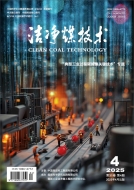Carbon footprint analysis of China′s ammonia energy production-storage-transportation-utilization full-chain for different application scenarios
 2024 No. 05
2024 No. 05
 1062
1062 590
590

Citation format:

Authors:
- WANG Minghua
- CHEN Zeyu
- WANG Wen
- REN Lei
- LIU Jianzhe
- OU Xunmin

Unit:
- CHN Energy Economic and Technological Research Institute Co.,Ltd.
- Institute of Energy,Environment and Economy,Tsinghua University

Abstract:
Ammonia energy is a widely used, green and low-carbon new type of clean energy, which has outstanding advantages over hydrogen energy in terms of safety, energy intensity, easy-to-storage and transport, and many other aspects. The application of ammonia energy in transportation, power, chemical and other sectors in China is still in its infancy, but the related carbon footprint research has received much attention. This study conducted a step-by-step life cycle carbon footprint analysis of China′s ammonia energy′s full industrialchain under application scenarios such as hydrogen refueling stations, ammonia fuel supply stations, and power plants, and focus on analyzing the carbon emission level of ammonia energy used in the scenario of transportation fuel and power sector. The research results showthat, from the perspective of different technology routs, in all scenarios, the carbon dioxide emissions of ammonia energy in the whole lifecycle of the electrolyzed water hydrogen production HB (Haber Bosch process) synthetic ammonia liquid ammonia vehicle route are thehighest, more than 600 g/ MJ. Hydrogen production from renewable energy electrolyzed water - HB synthetic ammonia - pipelinetransmission route has the lowest carbon dioxide emission in the whole life cycle of ammonia energy, which is lower than 40 g/ MJ. Foreach stage, the fuel production stage accounts for the highest proportion of carbon footprint in all stages of production, storage and application of various ammonia production technology pathway, except for the renewable energy electrolysis ammonia production pathway. Fromthe perspective of influencing factors, the power consumption level and its carbon emission factor in each stage of hydrogen production,ammonia generation and ammonia cracking for hydrogen production play an important role in the carbon footprint of the whole industrialchain of ammonia energy production, storage and utilization. From the perspective of application scenarios, in the scenarios of chemicalplants, steel plants, and power plants, due to the short transportation distance and low energy consumption for storage and transportation,the carbon dioxide emissions throughout the full life cycle of 1 MJ ammonia energy are relatively low. From the perspective of applicationscenarios, in the field of transportation, the green ammonia and blue ammonia technology pathway has the advantage of significantly reducing the carbon footprint (more than 80%) compared with traditional petroleum fuels.

Keywords:
- ammonia energy
- carbon footprint
- application scenario
- carbon neutrality
- low carbon energy
- low carbon fuel

Citation format:

Chart:

Articles:

-
Executive director
China Coal Science and Industry Group Co., Ltd
-
Sponsored by
Coal Science Research Institute Co., Ltd
Coal Industry Clean Coal Engineering
Technology Research Center -
Editor in Chief
XIE Qiang
-
Vice Editor-in-Chief
YU Chang
SHI Yixiang
ZHAO Yongchun
DUAN Linbo
CAO Jingpei
ZENG Jie -
Publication Frequencies
Monthly
-
ISSN
1006-6772
-
CN
11-3676/TD
Covered by
- CSTPCD
- RCCSE(A+)
- AJ
- EBSCO host
- Ulrichsweb
- JST
- Scopus
Contact us
New Media
-
 Meichuanmei
Meichuanmei -
 Clean Coal Technology
Clean Coal Technology -
 Online Journals
Online Journals




 Submission system
Submission system Copyright agreement
Copyright agreement Instructions for authors
Instructions for authors